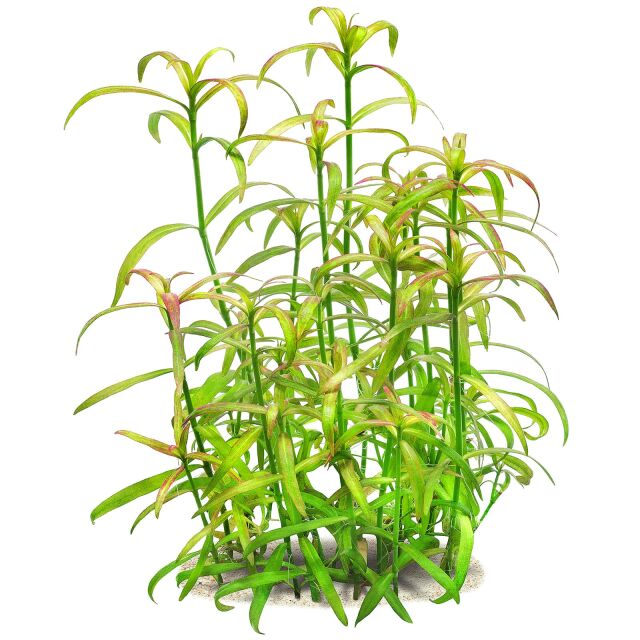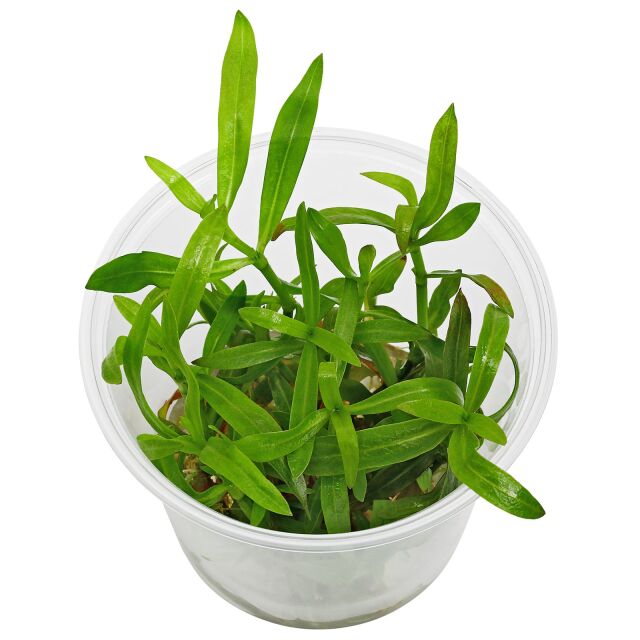


Diodia cf. kuntzei
- New stem plant from the Pantanal area
- Upright growth
- Leaves reddish under strong lighting
- Moderate growth rate
Sign in or Register
Item question
We’re here for you!
Please enter your question and e-mail and we’ll contact you as soon as possible. It usually takes us up to 24 hours during business days to respond.
Thank you for your question!
Thank you, we’ll get in touch!
Close window
You already sent us a question.
Please wait a few minutes
Description
This plant became known in the aquarium hobby under the name Hygrophila sp. "Pantanal" and was likely offered in Japan first. In Europe it is still a little known rarity. This stem plant has nothing to do with Hygrophila but belongs to the genus Diodia in the Rubiaceae family, thus it is a relative of woodruff and coffee tree. It is likely the south American species Diodia kuntzei, however its reliable determination is still pending (therefore the "cf." in the name). The Diodia species are terrestrial and swamp plant that also grow temporally submerged in their natural habitats. Diodia cf. kuntzei has straight, thin but strong stems; the lanceolate, opposite leaves are curved downwards and show a nice reddish colouration under strong lighting.
Diodia cf. kuntzei is not too difficult to grow, however we recommend rather strong lighting, a good CO2 (20-30 mg/l) and nutrient supply and rather soft water. Also a nutrient-rich substrate such as Aquasoil is beneficial. However this plant only develops very fine, rather few roots and anchors weakly in the substrate. Especially older stems are prone to uprooting; subsequent replanting of the stem tips is necessary. Put single stems with a little space to each other into the substrate. This Diodia is propagated by stem cuttings. Its growth rate is moderate, and it ramifies only sparsely. It is easier to grow emersed on moist to wet bottom, however its emersed leaves are medium green without reddish tones.
This stem plant is relatively large, as the shoots may get about 10 cm wide, however with its narrow leaves and thin stems it has a quite delicate texture. It looks well as an up to about 20 cm high group in the midground and should also be suitable for planting a "plant street" in Dutch style tanks. As a plant from the Pantanal wetland in South America, it is also interesting for biotope aquariums and paludariums with plants and fishes from that region.
This plant from the Brazilian Pantanal region was first considered to be a Hygrophila species, however, the characteristics of its inflorescence put it in the coffee family (Rubiaceae), and it is very probable that it belongs to the species Diodia kuntzei.
In the USA, Diodia cf. kuntzei has gained some popularity as aquarium plant under the name "Hygrophila sp. 'Pantanal' ". It is probably not yet cultivated in Europe.
-To be continued-
| Misapplied names | Hygrophila sp. 'Pantanal' |
| Family | Rubiaceae |
| Genus | Diodia |
| Difficulty | medium |
| Usage | Background, Midground |
| Growth | medium |
| Temperature tolerance | 20 - 30°C |
| General hardness | 0 - 30°dGH |
| Propagation | Cuttings |
| Can grow emersed? | yes |
| Source | Flowgrow |
| Misapplied names |
| Hygrophila sp. 'Pantanal' |
| Family |
| Rubiaceae |
| Genus |
| Diodia |
| Difficulty |
| medium |
| Usage |
| Background, Midground |
| Growth |
| medium |
| Temperature tolerance |
| 20 - 30°C |
| General hardness |
| 0 - 30°dGH |
| Propagation |
| Cuttings |
| Can grow emersed? |
| yes |
| Source |
| Flowgrow |
General information
Please choose a variant to see more information.
| Item no. |
|
| EAN | |
| Weight | |
| Shipping weight |
Customers ask customers
You have questions about this product? Ask other customer or our support team about this product!